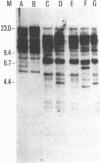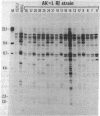Abstract
Cytochromes P-450 represent a superfamily of enzymes with a central role in the metabolism of drugs, chemical toxins, and carcinogens. We have used genetic analysis to establish the complexity and catalytic function of a recently identified constitutively expressed murine hepatic cytochrome P-450 encoded by P450-2C. Southern blotting analysis shows that there are at least seven or eight genes within this family in the mouse and rat and that DNA restriction fragment length variants between different mouse inbred strains are observed. Analysis of recombinant inbred strains derived from these parent strains shows (i) these genes are clustered within 1 centimorgan, (ii) this gene family does not correspond to any of the known cytochrome P-450 loci or map near any well-characterized genomic markers, and (iii) this gene family segregates to within 1-2 centimorgans of a locus controlling constitutive aryl hydrocarbon hydroxylase activity in mice. With use of Chinese hamster/mouse somatic cell hybrids, the P450-2C locus was assigned to a region of mouse chromosome 19 that appears to be syntenic with the previously mapped human P450C2C locus on human chromosome 10. By in situ hybridization to mitotic mouse chromosomes, we have localized this region to the tip of chromosome 19. These results are discussed in relation to the physiological roles of this P-450 family in foreign compound metabolism and steroid oxidations.
Full text
PDF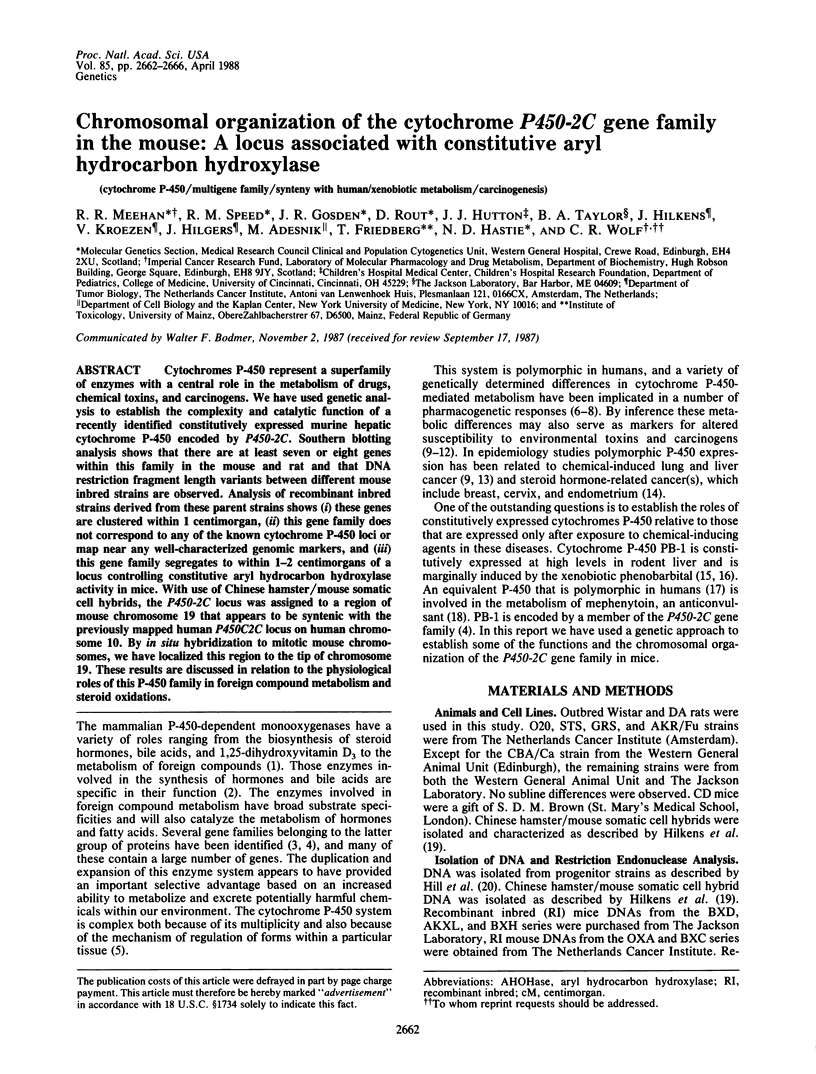
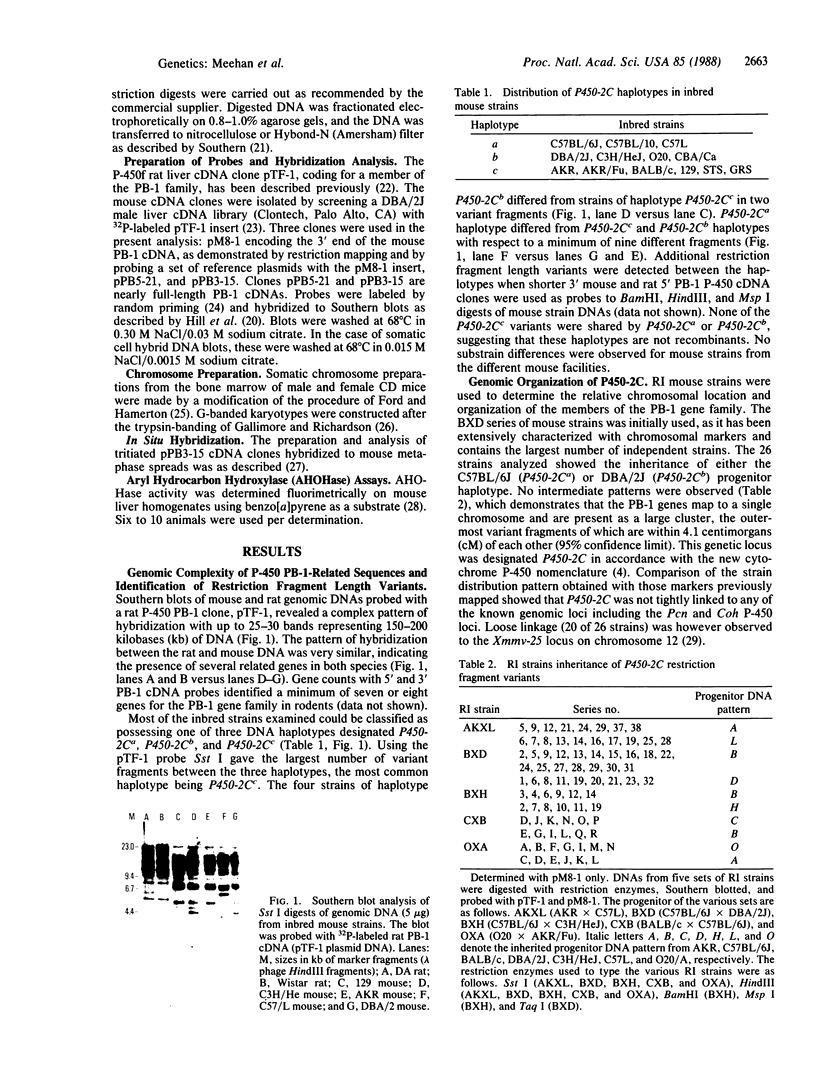
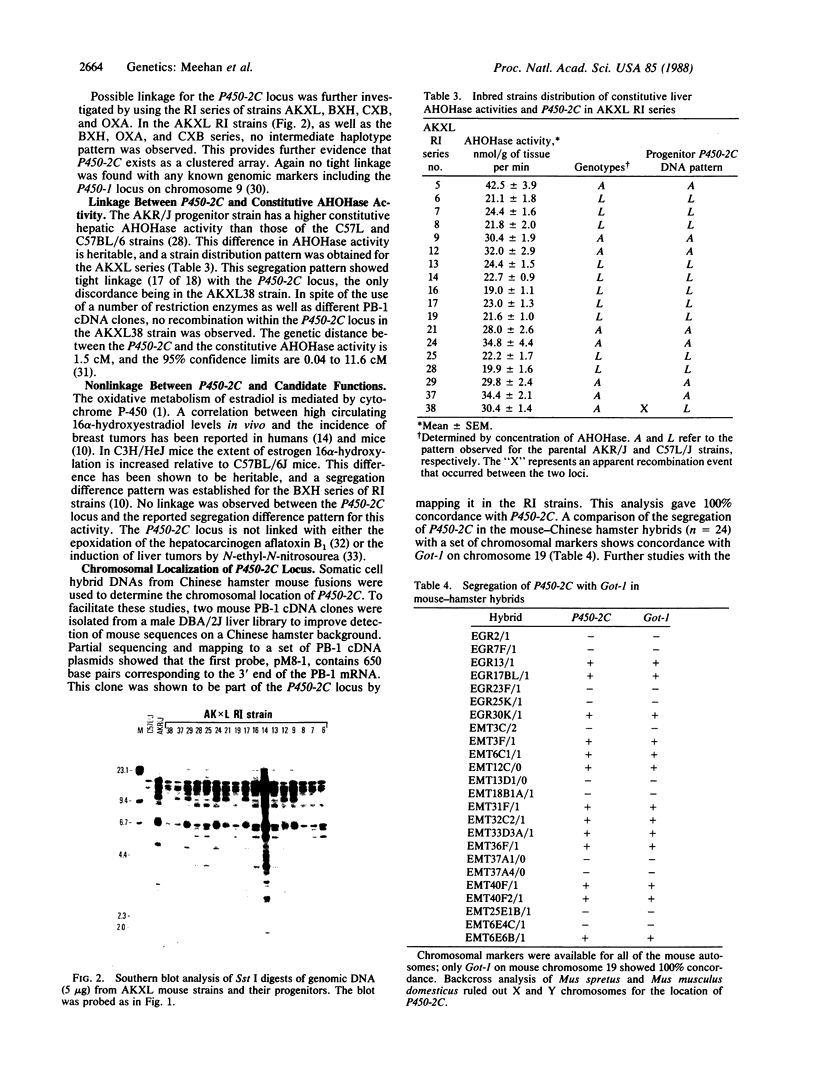
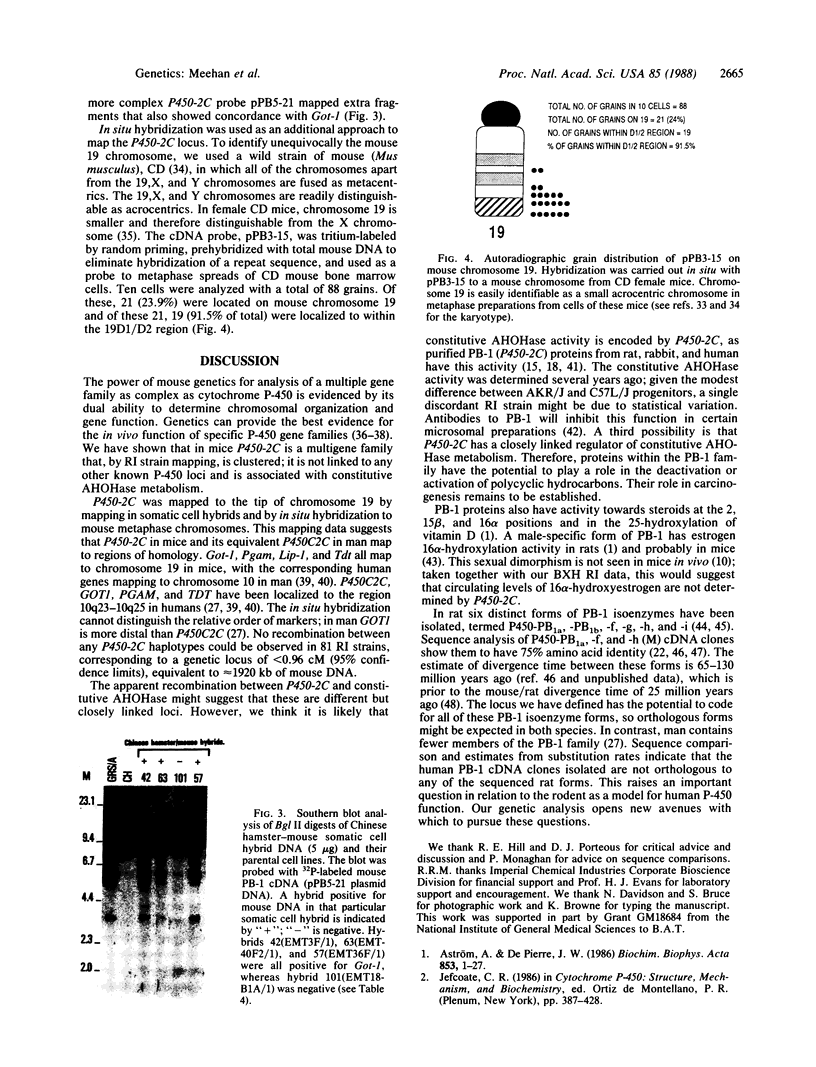
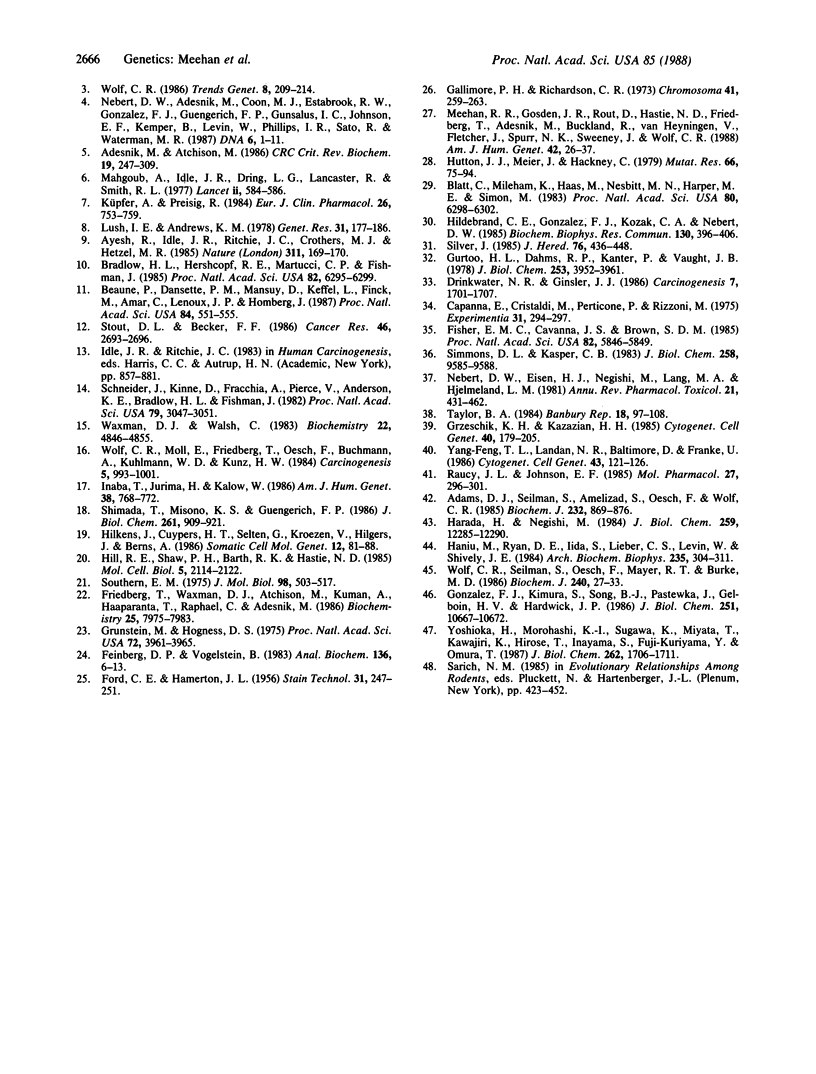
Images in this article
Selected References
These references are in PubMed. This may not be the complete list of references from this article.
- Adams D. J., Seilman S., Amelizad Z., Oesch F., Wolf C. R. Identification of human cytochromes P-450 analogous to forms induced by phenobarbital and 3-methylcholanthrene in the rat. Biochem J. 1985 Dec 15;232(3):869–876. doi: 10.1042/bj2320869. [DOI] [PMC free article] [PubMed] [Google Scholar]
- Adesnik M., Atchison M. Genes for cytochrome P-450 and their regulation. CRC Crit Rev Biochem. 1986;19(3):247–305. doi: 10.3109/10409238609084657. [DOI] [PubMed] [Google Scholar]
- Aström A., DePierre J. W. Rat-liver microsomal cytochrome P-450: purification, characterization, multiplicity and induction. Biochim Biophys Acta. 1986 Nov 4;853(1):1–27. doi: 10.1016/0304-4173(86)90002-9. [DOI] [PubMed] [Google Scholar]
- Beaune P., Dansette P. M., Mansuy D., Kiffel L., Finck M., Amar C., Leroux J. P., Homberg J. C. Human anti-endoplasmic reticulum autoantibodies appearing in a drug-induced hepatitis are directed against a human liver cytochrome P-450 that hydroxylates the drug. Proc Natl Acad Sci U S A. 1987 Jan;84(2):551–555. doi: 10.1073/pnas.84.2.551. [DOI] [PMC free article] [PubMed] [Google Scholar]
- Blatt C., Mileham K., Haas M., Nesbitt M. N., Harper M. E., Simon M. I. Chromosomal mapping of the mink cell focus-inducing and xenotropic env gene family in the mouse. Proc Natl Acad Sci U S A. 1983 Oct;80(20):6298–6302. doi: 10.1073/pnas.80.20.6298. [DOI] [PMC free article] [PubMed] [Google Scholar]
- Bradlow H. L., Hershcopf R. J., Martucci C. P., Fishman J. Estradiol 16 alpha-hydroxylation in the mouse correlates with mammary tumor incidence and presence of murine mammary tumor virus: a possible model for the hormonal etiology of breast cancer in humans. Proc Natl Acad Sci U S A. 1985 Sep;82(18):6295–6299. doi: 10.1073/pnas.82.18.6295. [DOI] [PMC free article] [PubMed] [Google Scholar]
- Cappana E., Cristaldi M., Perticone P., Rizzoni M. Identification of chromosomes involved in the 9 Robertsonian fusions of the Apennine mouse with a 22-chromosome karyotype. Experientia. 1975 Mar 15;31(3):294–296. doi: 10.1007/BF01922545. [DOI] [PubMed] [Google Scholar]
- Drinkwater N. R., Ginsler J. J. Genetic control of hepatocarcinogenesis in C57BL/6J and C3H/HeJ inbred mice. Carcinogenesis. 1986 Oct;7(10):1701–1707. doi: 10.1093/carcin/7.10.1701. [DOI] [PubMed] [Google Scholar]
- FORD C. E., HAMERTON J. L. A colchicine, hypotonic citrate, squash sequence for mammalian chromosomes. Stain Technol. 1956 Nov;31(6):247–251. doi: 10.3109/10520295609113814. [DOI] [PubMed] [Google Scholar]
- Feinberg A. P., Vogelstein B. A technique for radiolabeling DNA restriction endonuclease fragments to high specific activity. Anal Biochem. 1983 Jul 1;132(1):6–13. doi: 10.1016/0003-2697(83)90418-9. [DOI] [PubMed] [Google Scholar]
- Fisher E. M., Cavanna J. S., Brown S. D. Microdissection and microcloning of the mouse X chromosome. Proc Natl Acad Sci U S A. 1985 Sep;82(17):5846–5849. doi: 10.1073/pnas.82.17.5846. [DOI] [PMC free article] [PubMed] [Google Scholar]
- Friedberg T., Waxman D. J., Atchison M., Kumar A., Haaparanta T., Raphael C., Adesnik M. Isolation and characterization of cDNA clones for cytochromes P-450 immunochemically related to rat hepatic P-450 form PB-1. Biochemistry. 1986 Dec 2;25(24):7975–7983. doi: 10.1021/bi00372a028. [DOI] [PubMed] [Google Scholar]
- Gallimore P. H., Richardson C. R. An improved banding technique exemplified in the karyotype analysis of two strains of rat. Chromosoma. 1973;41(3):259–263. doi: 10.1007/BF00344020. [DOI] [PubMed] [Google Scholar]
- Gonzalez F. J., Kimura S., Song B. J., Pastewka J., Gelboin H. V., Hardwick J. P. Sequence of two related P-450 mRNAs transcriptionally increased during rat development. An R.dre.1 sequence occupies the complete 3' untranslated region of a liver mRNA. J Biol Chem. 1986 Aug 15;261(23):10667–10672. [PubMed] [Google Scholar]
- Grunstein M., Hogness D. S. Colony hybridization: a method for the isolation of cloned DNAs that contain a specific gene. Proc Natl Acad Sci U S A. 1975 Oct;72(10):3961–3965. doi: 10.1073/pnas.72.10.3961. [DOI] [PMC free article] [PubMed] [Google Scholar]
- Grzeschik K. H., Kazazian H. H. Report of the Committee on the Genetic Constitution of Chromosomes 10, 11, and 12. Cytogenet Cell Genet. 1985;40(1-4):179–205. doi: 10.1159/000132174. [DOI] [PubMed] [Google Scholar]
- Gurtoo H. L., Dahms R. P., Kanter P., Vaught J. B. Association and dissociation of the Ah locus with the metabolism of aflatoxin B1 by mouse liver. Co-segregation of aflatoxin B1 hydroxylase induction with aryl hydrocarbon (benzo(a)pyrene) hydroxylase induction. J Biol Chem. 1978 Jun 10;253(11):3952–3961. [PubMed] [Google Scholar]
- Haniu M., Ryan D. E., Iida S., Lieber C. S., Levin W., Shively J. E. NH2-terminal sequence analyses of four rat hepatic microsomal cytochromes P-450. Arch Biochem Biophys. 1984 Dec;235(2):304–311. doi: 10.1016/0003-9861(84)90202-9. [DOI] [PubMed] [Google Scholar]
- Harada N., Negishi M. Mouse liver testosterone 16 alpha-hydroxylase (cytochrome P-450(16) alpha). Purification, regioselectivity, stereospecificity, and immunochemical characterization. J Biol Chem. 1984 Oct 10;259(19):12285–12290. [PubMed] [Google Scholar]
- Hildebrand C. E., Gonzalez F. J., Kozak C. A., Nebert D. W. Regional linkage analysis of the dioxin-inducible P-450 gene family on mouse chromosome 9. Biochem Biophys Res Commun. 1985 Jul 16;130(1):396–406. doi: 10.1016/0006-291x(85)90430-9. [DOI] [PubMed] [Google Scholar]
- Hilkens J., Cuypers H. T., Selten G., Kroezen V., Hilgers J., Berns A. Genetic mapping of Pim-1 putative oncogene to mouse chromosome 17. Somat Cell Mol Genet. 1986 Jan;12(1):81–88. doi: 10.1007/BF01560730. [DOI] [PubMed] [Google Scholar]
- Hill R. E., Shaw P. H., Barth R. K., Hastie N. D. A genetic locus closely linked to a protease inhibitor gene complex controls the level of multiple RNA transcripts. Mol Cell Biol. 1985 Aug;5(8):2114–2122. doi: 10.1128/mcb.5.8.2114. [DOI] [PMC free article] [PubMed] [Google Scholar]
- Hutton J. J., Meier J., Hackney C. Comparison of the in vitro mutagenicity and metabolism of dimethylnitrosamine and benzo[a]pyrene in tissues from inbred mice treated with phenobarbital, 3-methylcholanthrene or polychlorinated biphenyls. Mutat Res. 1979 Jan;66(1):75–94. doi: 10.1016/0165-1218(79)90010-7. [DOI] [PubMed] [Google Scholar]
- Inaba T., Jurima M., Kalow W. Family studies of mephenytoin hydroxylation deficiency. Am J Hum Genet. 1986 May;38(5):768–772. [PMC free article] [PubMed] [Google Scholar]
- Küpfer A., Preisig R. Pharmacogenetics of mephenytoin: a new drug hydroxylation polymorphism in man. Eur J Clin Pharmacol. 1984;26(6):753–759. doi: 10.1007/BF00541938. [DOI] [PubMed] [Google Scholar]
- Lush I. E., Andrews K. M. Genetic variation between mice in their metabolism of coumarin and its derivatives. Genet Res. 1978 Apr;31(2):177–186. doi: 10.1017/s0016672300017936. [DOI] [PubMed] [Google Scholar]
- Mahgoub A., Idle J. R., Dring L. G., Lancaster R., Smith R. L. Polymorphic hydroxylation of Debrisoquine in man. Lancet. 1977 Sep 17;2(8038):584–586. doi: 10.1016/s0140-6736(77)91430-1. [DOI] [PubMed] [Google Scholar]
- Meehan R. R., Gosden J. R., Rout D., Hastie N. D., Friedberg T., Adesnik M., Buckland R., van Heyningen V., Fletcher J., Spurr N. K. Human cytochrome P-450 PB-1: a multigene family involved in mephenytoin and steroid oxidations that maps to chromosome 10. Am J Hum Genet. 1988 Jan;42(1):26–37. [PMC free article] [PubMed] [Google Scholar]
- Nebert D. W., Adesnik M., Coon M. J., Estabrook R. W., Gonzalez F. J., Guengerich F. P., Gunsalus I. C., Johnson E. F., Kemper B., Levin W. The P450 gene superfamily: recommended nomenclature. DNA. 1987 Feb;6(1):1–11. doi: 10.1089/dna.1987.6.1. [DOI] [PubMed] [Google Scholar]
- Nebert D. W., Eisen H. J., Negishi M., Lang M. A., Hjelmeland L. M., Okey A. B. Genetic mechanisms controlling the induction of polysubstrate monooxygenase (P-450) activities. Annu Rev Pharmacol Toxicol. 1981;21:431–462. doi: 10.1146/annurev.pa.21.040181.002243. [DOI] [PubMed] [Google Scholar]
- Raucy J. L., Johnson E. F. Variations among untreated rabbits in benzo(a)pyrene metabolism and its modulation by 7,8-benzoflavone. Mol Pharmacol. 1985 Feb;27(2):296–301. [PubMed] [Google Scholar]
- Schneider J., Kinne D., Fracchia A., Pierce V., Anderson K. E., Bradlow H. L., Fishman J. Abnormal oxidative metabolism of estradiol in women with breast cancer. Proc Natl Acad Sci U S A. 1982 May;79(9):3047–3051. doi: 10.1073/pnas.79.9.3047. [DOI] [PMC free article] [PubMed] [Google Scholar]
- Shimada T., Misono K. S., Guengerich F. P. Human liver microsomal cytochrome P-450 mephenytoin 4-hydroxylase, a prototype of genetic polymorphism in oxidative drug metabolism. Purification and characterization of two similar forms involved in the reaction. J Biol Chem. 1986 Jan 15;261(2):909–921. [PubMed] [Google Scholar]
- Silver J. Confidence limits for estimates of gene linkage based on analysis of recombinant inbred strains. J Hered. 1985 Nov-Dec;76(6):436–440. doi: 10.1093/oxfordjournals.jhered.a110140. [DOI] [PubMed] [Google Scholar]
- Simmons D. L., Kasper C. B. Genetic polymorphisms for a phenobarbital-inducible cytochrome P-450 map to the Coh locus in mice. J Biol Chem. 1983 Aug 25;258(16):9585–9588. [PubMed] [Google Scholar]
- Southern E. M. Detection of specific sequences among DNA fragments separated by gel electrophoresis. J Mol Biol. 1975 Nov 5;98(3):503–517. doi: 10.1016/s0022-2836(75)80083-0. [DOI] [PubMed] [Google Scholar]
- Waxman D. J., Walsh C. Cytochrome P-450 isozyme 1 from phenobarbital-induced rat liver: purification, characterization, and interactions with metyrapone and cytochrome b5. Biochemistry. 1983 Sep 27;22(20):4846–4855. doi: 10.1021/bi00289a035. [DOI] [PubMed] [Google Scholar]
- Wolf C. R., Moll E., Friedberg T., Oesch F., Buchmann A., Kuhlmann W. D., Kunz H. W. Characterization, localization and regulation of a novel phenobarbital-inducible form of cytochrome P450, compared with three further P450-isoenzymes, NADPH P450-reductase, glutathione transferases and microsomal epoxide hydrolase. Carcinogenesis. 1984 Aug;5(8):993–1001. doi: 10.1093/carcin/5.8.993. [DOI] [PubMed] [Google Scholar]
- Wolf C. R., Seilman S., Oesch F., Mayer R. T., Burke M. D. Multiple forms of cytochrome P-450 related to forms induced marginally by phenobarbital. Differences in structure and in the metabolism of alkoxyresorufins. Biochem J. 1986 Nov 15;240(1):27–33. doi: 10.1042/bj2400027. [DOI] [PMC free article] [PubMed] [Google Scholar]
- Yang-Feng T. L., Landau N. R., Baltimore D., Francke U. The terminal deoxynucleotidyltransferase gene is located on human chromosome 10 (10q23----q24) and on mouse chromosome 19. Cytogenet Cell Genet. 1986;43(3-4):121–126. doi: 10.1159/000132309. [DOI] [PubMed] [Google Scholar]
- Yoshioka H., Morohashi K., Sogawa K., Miyata T., Kawajiri K., Hirose T., Inayama S., Fujii-Kuriyama Y., Omura T. Structural analysis and specific expression of microsomal cytochrome P-450(M-1) mRNA in male rat livers. J Biol Chem. 1987 Feb 5;262(4):1706–1711. [PubMed] [Google Scholar]



